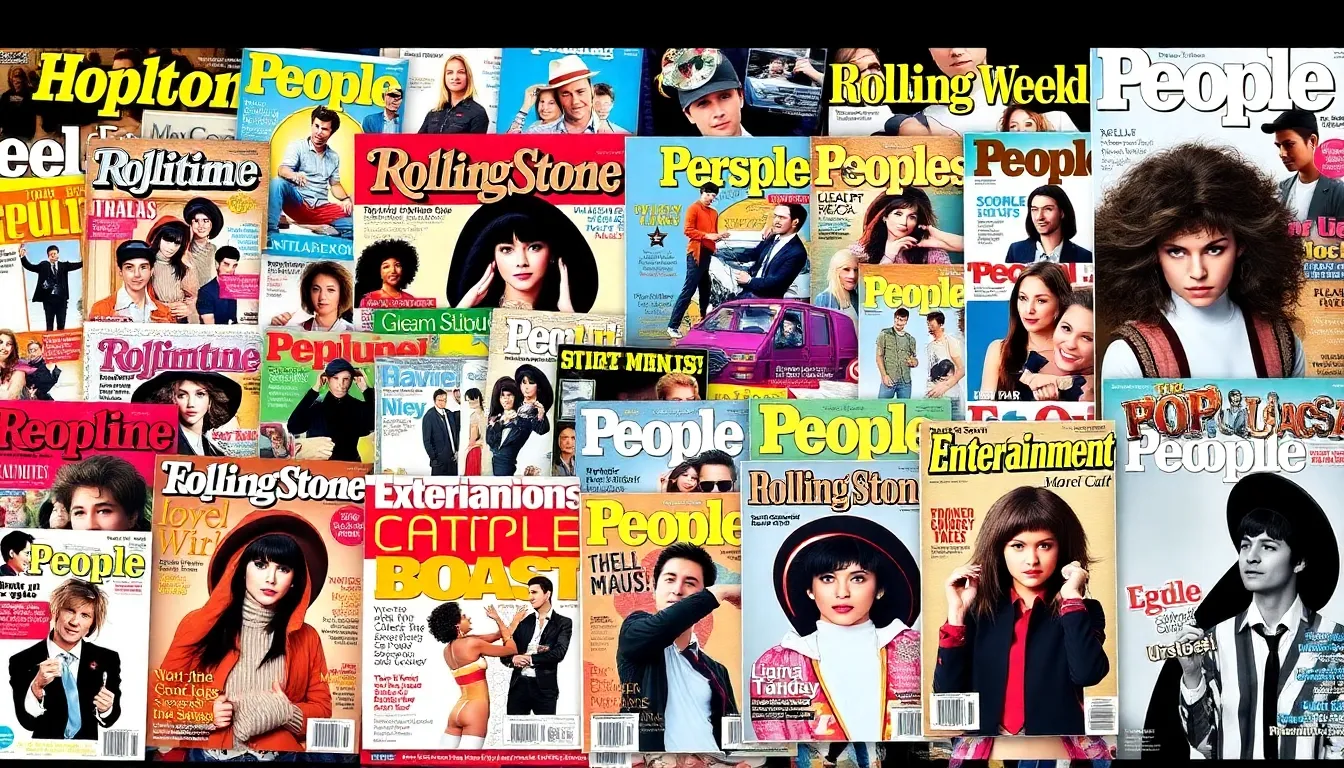Table of Contents
ToggleIn a world where memes reign supreme and celebrity gossip spreads faster than wildfire, pop culture magazines are the ultimate guilty pleasure. They’re the colorful portals that transport readers into the glitzy universe of Hollywood, fashion, and the latest viral trends. Whether it’s dissecting the latest red carpet looks or uncovering the juicy details behind a celebrity breakup, these magazines serve up entertainment with a side of sass.
But it’s not just about the drama; pop culture magazines offer a unique lens into society’s ever-changing tastes and trends. They reflect what’s hot and what’s not, all while keeping readers chuckling and craving more. So grab your favorite snack, flip through those glossy pages, and dive into the whirlwind of pop culture that keeps everyone talking. After all, who wouldn’t want to stay in the loop while enjoying a good laugh?
Overview of Pop Culture Magazines
Pop culture magazines serve as vibrant reflections of contemporary society. Focusing on celebrities, music, movies, and more, these publications attract diverse audiences eager for entertainment updates. Their engaging content captivates readers while delivering a mix of humor and drama.
Trends often emerge in these magazines, showcasing evolving fashion styles and social movements. Features typically include interviews with artists and entertainers, providing insights into their lives and creative processes. Editorials frequently highlight the latest viral trends, appealing to readers’ curiosities and interests.
Each issue presents visually stimulating layouts filled with colorful images and bold headlines. Readers encounter a blend of investigative reporting and lighthearted commentary, enriching their understanding of cultural phenomena. Popular titles within this genre include Entertainment Weekly, People, and Rolling Stone. These magazines maintain a dynamic presence in the industry, adapting to shifting trends and audience preferences.
Social media influences the way pop culture magazines interact with their readership. Many magazines have embraced digital platforms, offering online content and interactive experiences. This evolution ensures that fans stay connected and engaged beyond the printed page. Consequently, pop culture magazines remain key players in shaping trends, reflecting societal values, and entertaining global audiences.
History of Pop Culture Magazines

Pop culture magazines hold a vibrant place in the media landscape, reflecting cultural shifts and trends through the decades.
The Evolution Over Decades
Emerging in the late 19th century, pop culture magazines initially catered to societal interests and entertainment. In the 1960s, counterculture movements propelled magazines like Rolling Stone into prominence, focusing on music and social commentary. The 1980s and 1990s saw an explosion of celebrity-focused content, with titles like People gaining popularity by covering personal stories of public figures. Millennial audiences shifted preferences towards digital formats, leading magazines to adapt and thrive online. Throughout this evolution, visual appeal increased significantly, engaging readers with striking layouts and compelling imagery.
Key Milestones in Publication
1971 marked the first issue of Rolling Stone, a groundbreaking publication that influenced music journalism. In 1974, People magazine made its debut, focusing on celebrity news and human interest stories. The 1990s introduced Teen Vogue, targeting younger demographics with fashion and lifestyle content. By the early 2000s, Entertainment Weekly debuted, providing comprehensive coverage of film, television, and pop culture trends. The impact of social media emerged in the 2010s, prompting many magazines to embrace digital platforms, ensuring content reaches a broader audience promptly. These milestones showcase the adaptability and relevance of pop culture magazines in an ever-changing landscape.
Impact on Society and Culture
Pop culture magazines significantly influence society and culture, shaping perceptions and understanding of contemporary issues.
Shaping Public Opinion
Public opinion often finds its voice in the pages of pop culture magazines. These publications highlight trending topics relevant to society, allowing readers to engage with important dialogues. By spotlighting various issues, they can sway individuals’ views on matters like celebrity behavior, social justice, and political events. Celebrities interviewed in these magazines frequently share personal insights that resonate with the audience, encouraging discussions around cultural beliefs and values. Data shows that 63% of readers trust magazine articles for their entertainment insights, emphasizing the magazines’ role in shaping consumer perspectives. Thus, a well-crafted article can spark curiosity, alter perceptions, and inspire action among readers.
Reflecting Trends and Movements
Trends and movements prominently feature in pop culture magazines, serving as mirrors to society. Fashion trends, social movements, and lifestyle choices appear front and center, showcasing the cultural evolution over time. When a magazine highlights an emerging trend, it often provides validation and visibility to specific styles or causes, driving public interest. For example, the rise of sustainable fashion gained traction as magazines began to cover eco-friendly brands and practices. In the digital age, the speed at which trends spread is unmatched, with influencers and publications sharing content widely. Tracking these shifts demonstrates how deeply intertwined pop culture magazines are with current societal dynamics, illustrating their significance in contemporary culture.
Popular Pop Culture Magazines Today
Pop culture magazines remain vital sources of entertainment and insights. They capture the essence of current trends and societal shifts.
Top Contenders in the Industry
Entertainment Weekly, People, and Rolling Stone stand out among leading pop culture magazines. Each publication adapts to changing audience preferences and industry trends. Entertainment Weekly focuses on movies and television, providing engaging reviews and interviews. People magazine highlights celebrity lives, offering in-depth profiles and exclusive gossip. Rolling Stone centers on music and culture, featuring artists and influential figures. These titles resonate with diverse readers, showcasing their ongoing relevance in the pop culture landscape.
Special Features and Content
Special features in pop culture magazines create distinct reading experiences. Many issues include exclusive interviews with music stars, actors, and influencers. Readers engage with entertaining columns that cover fashion, lifestyle, and trending topics. Magazine layouts often showcase vibrant photography and eye-catching graphics, enhancing visual appeal. Monthly issues frequently highlight societal issues, reflecting global movements and trends. Various publications now offer interactive content through digital platforms, fostering deeper connections with readers. This blend of traditional and modern features ensures these magazines remain fresh and engaging.
The Future of Pop Culture Magazines
The future of pop culture magazines reflects the increasing integration of digital media and evolving audience preferences.
Digital Transformation
Digital transformation shapes the landscape of pop culture magazines. With online platforms gaining popularity, traditional print formats face challenges. Many publications expand their digital presence to engage younger audiences. Websites, social media, and mobile apps allow deeper connections with readers. Interactive content enhances user experience, offering polls, quizzes, and live chats. Additionally, multimedia formats, such as podcasts and videos, complement written articles, resulting in a rich narrative experience. Maintaining relevance is key; thus, magazines adapt to shifting consumption habits. Research shows that digital subscribers prefer instant access to celebrity news, driving the evolution of these magazines.
Emerging Trends to Watch
Emerging trends in pop culture magazines spotlight how culture continues to evolve. An emphasis on inclusivity appears increasingly important; varied representation reflects diverse audience perspectives. Sustainability frequently garners attention, with magazines featuring eco-friendly fashion and lifestyle choices. Trend analysis reveals that mental health and wellness topics resonate with readers. Popular opinion also influences content direction; social movements gain visibility through interviews and features. Lastly, personalization in marketing emerges as a significant trend as magazines leverage data to curate content tailored to individual preferences. Observing these trends provides insight into the dynamic relationship between pop culture and societal shifts.
Pop culture magazines continue to thrive as essential sources of entertainment and insight. They not only capture the essence of current trends but also reflect the ever-changing dynamics of society. By blending humor and drama with in-depth interviews and vibrant visuals, these publications create engaging experiences for readers.
As they adapt to the digital age and embrace new technologies, pop culture magazines remain relevant and influential. Their ability to spark conversations and shape public opinion ensures they’ll continue to resonate with diverse audiences. The ongoing evolution of these magazines highlights their importance in understanding contemporary culture and staying connected to the world of entertainment.







